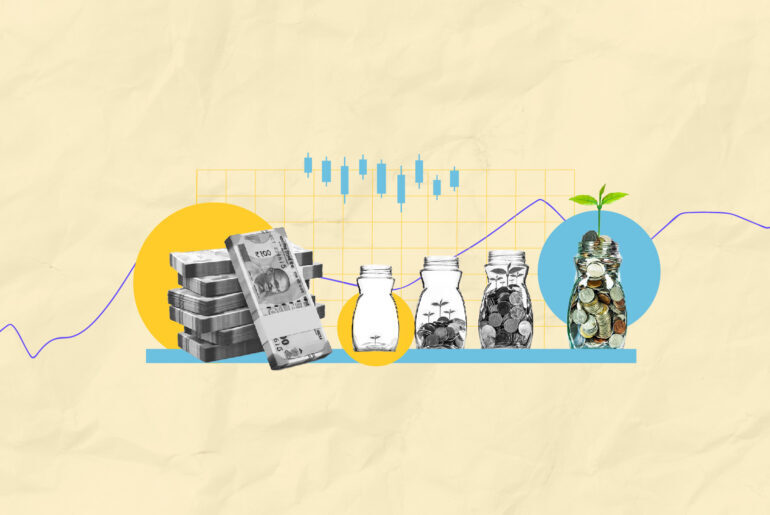Last Updated on Sep 16, 2022 by
Need, willingness, and money are common factors that influence stock investing and online purchases. In both cases, you have a need that drives your willingness to invest funds so you can earn returns or spend a portion of your income to fulfil a requirement.
Then a question arises, if, in both the cases, you are trading money for something in return, why can’t investing in shares be as simple as buying a product or service on an online market? That is, make bulk purchases by adding your desired products to the online shopping cart and check out all at once! Doesn’t this save time and energy?
Table of Contents
A table describing the drivers of stock investments or online purchases
As mentioned, whether you are investing in stocks or purchasing a good on an e-commerce site, there are underlying factors that make you do what you do.
| Drivers | Stock market | E-commerce |
| Need | To earn returns | To fulfil a requirement |
| Willingness | To assume a high risk | To spend on an existing or new product |
| Money | Earmarking savings | Setting aside a portion of the budget for expenses |
The same 3 factors influence stock investments and e-commerce purchases. But, investing in shares and buying a product or service on an e-commerce site are distinct activities. They are governed by different rules, beliefs, and motives, which make a stock investor’s journey much more complex than that of an online buyer’s. Let’s compare the two and understand why.
Human psychology and behaviour when investing in stocks or making an online purchase
Human behaviour, be it in a multiplex, a stock market or even on an e-commerce site, is determined by psychological traits. Let’s dive into the details. Each step of investing and buying journey is influenced by psychological traits as discussed below.
Analysing a stock or a product
You may have heard that doing fundamental analysis is quintessential to investing in shares. Well, some investors prefer technical analysis, and that works too. But usually, long-term investors resort to the former type. Whatsoever, researching and analysing a company before investing in its stock is crucial and so is researching a product/service before purchasing it on an e-commerce site.
Only, in this case, you don’t have to study several years’ annual reports of the seller to track their performance. Why would you? You aren’t betting on the company or buying a stake in it. Most importantly, you aren’t entitled to a share of profits or dividends of the company. Nevertheless, you may have to scour through the product reviews or testimonials of the seller before making the right buying decision. This is especially true if you are buying a product for the first time.
Decision-making window
In both the cases—buying a stock and purchasing a good or service on an e-commerce site—an investor and a buyer have to forgo an amount of money. The only difference is that, as an investor, you pay for a stock out of the money you earmark as savings whereas, as a buyer, you spend a portion of your monthly budget that you set aside to meet expenses.
But even with money going out in both the cases, a prudent investor is more likely to spend a considerable amount of time on investigating a company and the stock before making a buying decision because this involves an expectation to earn a handsome return. Moreover, stock markets are risky and there are chances where the investor may even lose their capital, let alone the returns.
On the other hand, as an online buyer of goods, you may not spend the same time in deciding whether or not to purchase a product, unless it is a big-ticket good, in which case, researching the product also takes significant time.
Buying price of a stock or a product
Among other things, the demand for a stock is a vital determinant of the movement of its price. For instance, as the demand for a stock increases, so does its price and vice versa. But, there’s also a lesser-conceived factor that influences the prices of a stock. It is investor psychology. If investors collectively favour a particular stock, its price increases because the supply remains constant. This means, investors are greedy and as a result, they are willing to pay a higher amount to buy that stock. The opposite is also true. Following are two instances of the same.
- When there’s good news about a company: Investors are more likely to bet on the stock because they think that the company has growth prospects. This shoots the share price and investors become bullish. But like everything else, a bull market can’t prevail always. After some point in time, investors sell their holdings to book profits. As a result, the price of the stock starts falling
- When there’s bad news about a company: Investors are more likely to sell their holdings as they view the scrip as a risky avenue to bet their money on. When more number of investors do this, the stock price starts declining. This is called a bearish behaviour. Again, a bear market has to recover at some point in time and so it does. This either happens when the company delivers good news or when opportunistic investors buy the scrip at lower prices to hold it until the price soars, after which, they liquidate their position to earn handsome returns
Clearly, investor sentiment and market sentiment are intertwined. Meaning, they influence each other. Ergo, it is not difficult to see that investor psychology determines market psychology and vice versa.
But this is not what generally happens on an e-commerce site. The price of a product, called the maximum retail price (MRP), is fixed. This comprises the cost that the seller incurs in building it and a profit margin. And on a normal day, buyers pay the MRP to obtain the product. But a stock-market like situation in the pricing of a product or a service is also possible in rare or unprecedented scenarios. The best example is now when the prices of face masks, sanitisers, and disinfectants are sky-rocketing due to the coronavirus pandemic.
Emotions governing investments and purchases
A wise investor always steers clear from emotions when buying or selling a stock. Being emotional when investing in a share market is the worst thing you can do to your stock portfolio. But as humans, investors tend to have two emotions, namely fear and greed, when transacting in a stock market. Fear is when investors feel a threat to their returns and greed is when they foresee a potential to earn higher returns. When moderated and contained, these emotions can help in either limiting the loss or giving a chance to earn higher returns.
However, just like how more of anything is dangerous, being overly emotional in stock investing clouds good judgement. This then turns out to be harmful to your stock portfolio. For instance, there’s always a point at which the uptrend of a stock price reverses. If you let go of the emotion called greed and sell the stock as per your investing plan, you can avoid incurring losses when the price starts declining. But if you hold on to the stock wishing to benefit from every price point that it gains, chances are that you will erase the gains that you may have made so far.
Ergo, it makes sense to have a rational investing plan in place, where you know your risk-return tolerance and accordingly fix the entry and exit points. Simply beware that the want for even just a little more can erase significant gains. Set a target for profit and loss to defeat your emotions and act rationally. Remember there is tomorrow when you can make more by risking less.
Containing emotions also applies when purchasing on an e-commerce site. It is no secret how a buyer can get carried away and add more products to the online shopping cart than necessary or they had initially planned for. While there’s no extreme risk-return factor that comes into the picture here, you may end up spending more than what you budgeted for, ultimately dipping into your savings. So, it’s best to keep your impulsive behaviour in check if you don’t wish to strain your finances.
Investing in stock or purchasing a product online
Once you research your desired stock or product and are convinced about its price, you decide whether to buy it or not. If you think it’s worth, you go ahead and transact. When it comes to buying the stock, you need to do it via a demat account, where you can only pay for stocks of the same company at one time. That is, you cannot buy stocks of two or more companies and pay for them at once. Say you are interested in buying 5 shares of RIL and 5 of ITC. You can only do it individually. That is, buy 5 shares of RIL first and 5 of ITC later.
On the other hand, buying multiple products on an e-commerce site is possible and convenient. All you need to do is add your desired products to the online shopping cart, check out, and pay at a single go. There you go, your online shopping is done.
Conclusion, can stock investing be as convenient as online purchasing?
So, don’t you feel that investing in shares of multiple companies is time-consuming and inconvenient too? It sure is. What if you want to invest in 15 different stocks? You have to transact 15 times! Phew, that’s such a tedious process. Then how wonderful would it be to buy multiple stocks at one go—just like how you buy your monthly groceries? Well, you’d love it and so we have a solution for it. Stay tuned to know more and yes, happy investing!
- Top Large Cap Funds (2025): Best Blue Chip Mutual Funds - Apr 15, 2025
- List of Best Index Funds in India 2025 - Apr 15, 2025
- List of High Beta Stocks in India: Volatile Shares on NSE - Apr 11, 2025




